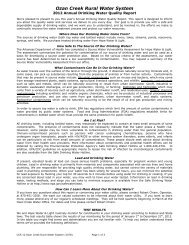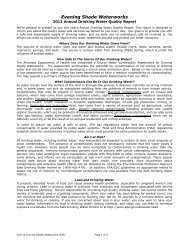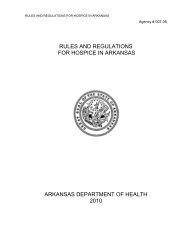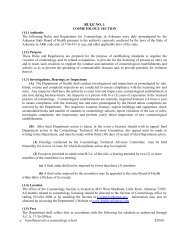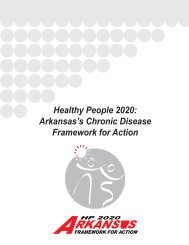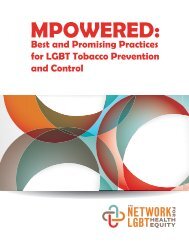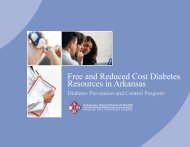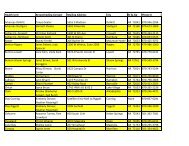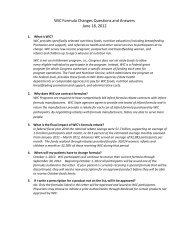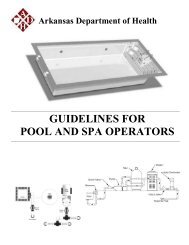Bentonville Water Utilities - Arkansas Department of Health
Bentonville Water Utilities - Arkansas Department of Health
Bentonville Water Utilities - Arkansas Department of Health
Create successful ePaper yourself
Turn your PDF publications into a flip-book with our unique Google optimized e-Paper software.
<strong>Bentonville</strong> <strong>Water</strong> <strong>Utilities</strong><br />
2012 Annual Drinking <strong>Water</strong> Quality Report<br />
We're pleased to present to you this year's Annual Drinking <strong>Water</strong> Quality Report. This report is<br />
designed to inform you about the quality water and services we deliver to you every day. Our goal is<br />
to provide you with a safe and dependable supply <strong>of</strong> drinking water, and we want you to understand,<br />
and be involved in, the efforts we make to continually improve the water treatment process and protect<br />
our water resources.<br />
Where Does Our Drinking <strong>Water</strong> Come From?<br />
The sources <strong>of</strong> drinking water (both tap water and bottled water) include rivers, lakes, streams, ponds,<br />
reservoirs, springs, and wells. We purchase treated surface water from Beaver <strong>Water</strong> District whose<br />
source is Beaver Lake.<br />
How Safe Is The Source Of Our Drinking <strong>Water</strong>?<br />
The <strong>Arkansas</strong> <strong>Department</strong> <strong>of</strong> <strong>Health</strong> has completed a Source <strong>Water</strong> Vulnerability Assessment for Beaver<br />
<strong>Water</strong> District. The assessment summarizes the potential for contamination <strong>of</strong> our source <strong>of</strong> drinking<br />
water and can be used as a basis for developing a source water protection plan. Based on the various<br />
criteria <strong>of</strong> the assessment, our water source has been determined to have a low susceptibility to<br />
contamination. You may request a summary <strong>of</strong> the Source <strong>Water</strong> Vulnerability Assessment from our<br />
<strong>of</strong>fice.<br />
What Contaminants Can Be In Our Drinking <strong>Water</strong>?<br />
As water travels over the surface <strong>of</strong> the land or through the ground, it dissolves naturally occurring<br />
minerals and, in some cases, can pick up substances resulting from the presence <strong>of</strong> animals or from<br />
human activity. Contaminants that may be present in source water include: Microbial contaminants<br />
such as viruses and bacteria, which may come from sewage treatment plants, septic systems,<br />
agricultural livestock operations, and wildlife; Inorganic contaminants such as salts and metals, which<br />
can be naturally occurring or result from urban stormwater run<strong>of</strong>f, industrial or domestic wastewater<br />
discharges, oil and gas production, mining, or farming; Pesticides and herbicides which may come from<br />
a variety <strong>of</strong> sources such as agriculture, urban stormwater run<strong>of</strong>f, and residential uses; Organic<br />
chemical contaminants including synthetic and volatile organic chemicals, which are by-products <strong>of</strong><br />
industrial processes and petroleum production, and can also come from gas stations, urban stormwater<br />
run<strong>of</strong>f, and septic systems; Radioactive contaminants which can be naturally occurring or be the result<br />
<strong>of</strong> oil and gas production and mining activities.<br />
In order to assure tap water is safe to drink, EPA has regulations which limit the amount <strong>of</strong> certain<br />
contaminants in water provided by public water systems. Food and Drug Administration (FDA)<br />
regulations establish limits for contaminants in bottled water which must provide the same protection<br />
for public health.<br />
Am I at Risk?<br />
All drinking water, including bottled water, may reasonably be expected to contain at least small<br />
amounts <strong>of</strong> some contaminants. The presence <strong>of</strong> contaminants does not necessarily indicate that the<br />
water poses a health risk. However, some people may be more vulnerable to contaminants in drinking<br />
water than the general population. Immuno-compromised persons such as persons with cancer<br />
undergoing chemotherapy, persons who have undergone organ transplants, people with HIV/AIDS or<br />
other immune system disorders, some elderly, and infants can be particularly at risk from small<br />
amounts <strong>of</strong> contamination. These people should seek advice about drinking water from their health care<br />
providers. More information about contaminants and potential health effects can be obtained by calling<br />
the Environmental Protection Agency’s Safe Drinking <strong>Water</strong> Hotline at 1-800-426-4791. In addition,<br />
EPA/CDC guidelines on appropriate means to lessen the risk <strong>of</strong> infection by microbiological<br />
contaminants are also available from the Safe Drinking <strong>Water</strong> Hotline.<br />
Lead and Drinking <strong>Water</strong><br />
If present, elevated levels <strong>of</strong> lead can cause serious health problems, especially for pregnant women<br />
and young children. Lead in drinking water is primarily from materials and components associated with<br />
service lines and home plumbing. We are responsible for providing high quality drinking water, but<br />
cannot control the variety <strong>of</strong> materials used in plumbing components.<br />
CCR 12 <strong>Bentonville</strong> <strong>Water</strong> <strong>Utilities</strong> (041) Page 1 <strong>of</strong> 3
When your water has been sitting for several hours, you can minimize the potential for lead exposure<br />
by flushing your tap for 30 seconds to 2 minutes before using water for drinking or cooking. If you are<br />
concerned about lead in your water, you may wish to have your water tested. Information on lead in<br />
drinking water, testing methods, and steps you can take to minimize exposure is available from the<br />
Safe Drinking <strong>Water</strong> Hotline or at http://www.epa.gov/safewater/lead.<br />
How Can I Learn More About Our Drinking <strong>Water</strong>?<br />
If you have any questions about this report or concerning your water utility, please contact Preston<br />
Newbill, <strong>Water</strong> <strong>Utilities</strong> Manager, at 479-271-3140. We want our valued customers to be informed<br />
about their water utility. If you want to learn more, please attend any <strong>of</strong> our regularly scheduled<br />
meetings. They are held on the second and fourth Tuesday <strong>of</strong> each month at 6:00 PM at 305 SW A<br />
Street.<br />
TEST RESULTS<br />
We and Beaver <strong>Water</strong> District routinely monitor for constituents in your drinking water according to<br />
Federal and State laws. The test results table shows the results <strong>of</strong> our monitoring for the period <strong>of</strong><br />
January 1 st to December 31 st , 2012. In the table you might find terms and abbreviations you are not<br />
familiar with. To help you better understand these terms we've provided the following definitions:<br />
Action Level - the concentration <strong>of</strong> a contaminant which, if exceeded, triggers treatment or other requirements which a water<br />
system must follow.<br />
Maximum Contaminant Level (MCL) - the highest level <strong>of</strong> a contaminant that is allowed in drinking water. MCLs are set as<br />
close to the MCLGs as feasible using the best available treatment technology.<br />
Maximum Contaminant Level Goal (MCLG) – unenforceable public health goal; the level <strong>of</strong> a contaminant in drinking water<br />
below which there is no known or expected risk to health. MCLGs allow for a margin <strong>of</strong> safety.<br />
Maximum Residual Disinfectant Level (MRDL) - the highest level <strong>of</strong> a disinfectant allowed in drinking water. There is<br />
convincing evidence that addition <strong>of</strong> a disinfectant is necessary for control <strong>of</strong> microbial contaminants.<br />
Maximum Residual Disinfectant Level Goal (MRDLG) - the level <strong>of</strong> a drinking water disinfectant below which there is no<br />
known or expected risk to health. MRDLGs do not reflect the benefits <strong>of</strong> the use <strong>of</strong> disinfectants to control microbial<br />
contaminants.<br />
Nephelometric Turbidity Unit (NTU) – a unit <strong>of</strong> measurement for the clarity <strong>of</strong> water. Turbidity in excess <strong>of</strong> 5 NTU is just<br />
noticeable to the average person.<br />
Parts per billion (ppb) - a unit <strong>of</strong> measurement for detected levels <strong>of</strong> contaminants in drinking water. One part per billion<br />
corresponds to one minute in 2,000 years, or a single penny in $10,000,000.<br />
Parts per million (ppm) – a unit <strong>of</strong> measurement for detected levels <strong>of</strong> contaminants in drinking water. One part per million<br />
corresponds to one minute in two years or a single penny in $10,000.<br />
Contaminant<br />
Violation<br />
Y/N<br />
Level Detected<br />
MICROBIOLOGICAL CONTAMINANTS<br />
MCLG<br />
Unit<br />
(Public <strong>Health</strong> Goal)<br />
MCL<br />
(Allowable Level)<br />
Major Sources in<br />
Drinking <strong>Water</strong><br />
Total Coliform<br />
Bacteria<br />
N None Present 0<br />
1 positive sample per<br />
month<br />
Naturally present in the<br />
environment<br />
Contaminant<br />
Turbidity<br />
(Beaver <strong>Water</strong><br />
District)<br />
<br />
Violation<br />
Y/N<br />
Level Detected<br />
Unit<br />
TURBIDITY<br />
MCLG<br />
(Public <strong>Health</strong> Goal)<br />
MCL<br />
(Allowable Level)<br />
Any measurement in<br />
excess <strong>of</strong> 1 NTU<br />
constitutes a violation<br />
A value less than 95%<br />
constitutes a violation<br />
Major Sources in<br />
Drinking <strong>Water</strong><br />
N<br />
Highest yearly sample<br />
result: 0.14<br />
Lowest monthly % <strong>of</strong> NTU<br />
NA<br />
Soil run<strong>of</strong>f<br />
samples meeting the<br />
turbidity limit: 100%<br />
Turbidity is a measurement <strong>of</strong> the cloudiness <strong>of</strong> water. Beaver <strong>Water</strong> District monitors it because it is a good indicator <strong>of</strong><br />
the effectiveness <strong>of</strong> their filtration system.<br />
INORGANIC CONTAMINANTS<br />
Contaminant<br />
Fluoride<br />
(Beaver <strong>Water</strong> District)<br />
Nitrate<br />
[as Nitrogen]<br />
(Beaver <strong>Water</strong> District)<br />
Violation<br />
Y/N<br />
N<br />
N<br />
Level Detected<br />
Highest Running<br />
Annual Average:<br />
0.62<br />
Range: 0.51 – 0.72<br />
Average: 0.86<br />
Range: 0.50 – 1.22<br />
Unit<br />
MCLG<br />
(Public <strong>Health</strong><br />
Goal)<br />
MCL<br />
(Allowable Level)<br />
ppm 4 4<br />
ppm 10 10<br />
Major Sources in Drinking <strong>Water</strong><br />
Erosion <strong>of</strong> natural deposits; water<br />
additive which promotes strong<br />
teeth<br />
Run<strong>of</strong>f from fertilizer use;<br />
leaching from septic tanks,<br />
sewage; erosion <strong>of</strong> natural<br />
deposits<br />
CCR 12 <strong>Bentonville</strong> <strong>Water</strong> <strong>Utilities</strong> (041) Page 2 <strong>of</strong> 3
Contaminant<br />
Lead<br />
(<strong>Bentonville</strong> <strong>Water</strong> <strong>Utilities</strong>)<br />
Copper<br />
(<strong>Bentonville</strong> <strong>Water</strong> <strong>Utilities</strong>)<br />
<br />
<br />
Number <strong>of</strong> Sites<br />
over Action Level<br />
LEAD AND COPPER TAP MONITORING<br />
90 th Percentile<br />
Result<br />
0




